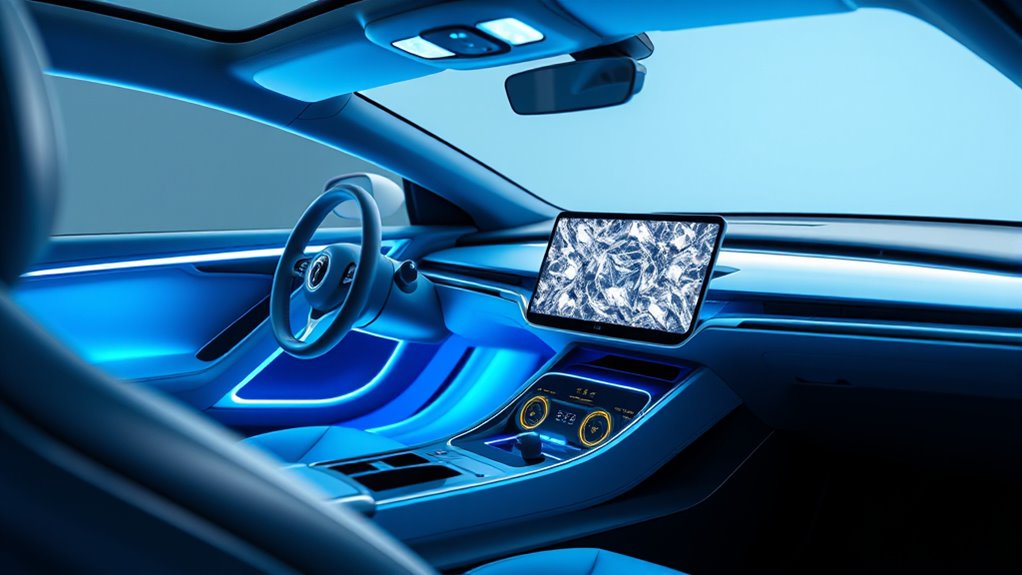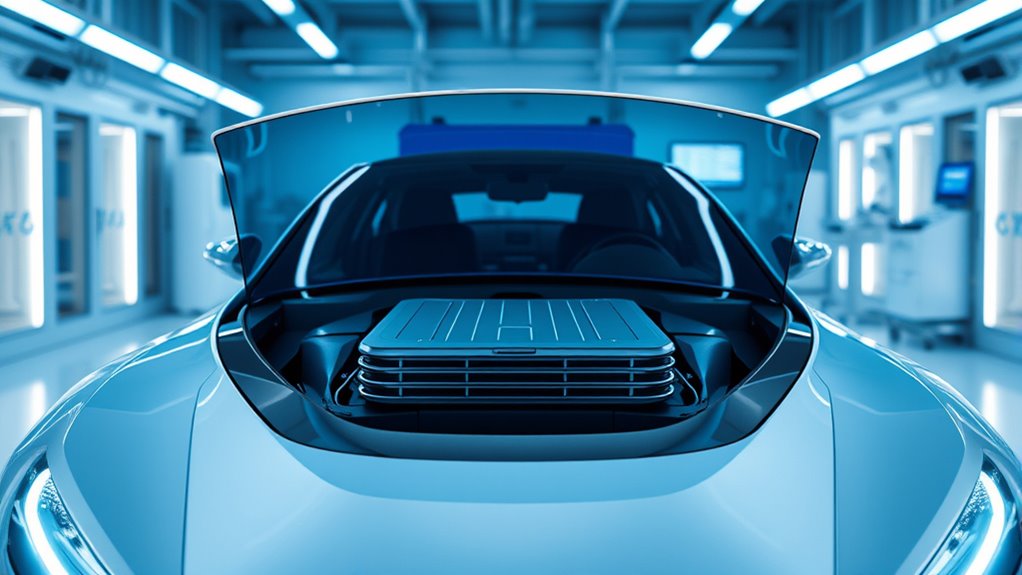Solid-state batteries are quietly revolutionizing electric cars by offering safer, more reliable, and faster-charging options. They use solid electrolytes that reduce fire risks associated with liquid electrolytes in traditional batteries. Although manufacturing challenges slow their widespread adoption, breakthrough innovations promise longer ranges and quicker charging in the future. If you want to discover how these advancements could transform your driving experience and what obstacles remain, there’s more to explore beyond this spotlight.
Key Takeaways
- Solid-state batteries offer safety improvements due to their less flammable solid electrolytes.
- They promise increased range and faster charging times for electric vehicles.
- Manufacturing challenges hinder large-scale production and increase costs.
- Overcoming production complexities is essential for widespread adoption of solid-state batteries.
- Advancements in technology could lead to safer, longer-range, and more efficient EVs in the future.

Solid-state batteries are rapidly emerging as a game-changer for electric cars, promising to improve safety, increase range, and shorten charging times. As you consider the future of EV technology, understanding the significance of these batteries is vital. One of their key advantages lies in battery safety. Unlike traditional lithium-ion batteries that use liquid electrolytes, solid-state batteries employ solid electrolytes, which are inherently less flammable. This reduces the risk of fires or explosions, a concern that has haunted electric vehicle adoption. With solid electrolytes, you get a safer power source that can withstand more stress and damage without compromising safety. This advancement not only enhances your confidence in electric cars but also paves the way for broader acceptance and deployment.
However, while the benefits are promising, manufacturing challenges remain a significant hurdle. Producing solid-state batteries at scale isn’t straightforward. The materials involved are often complex and require precise handling. For instance, creating a reliable interface between the solid electrolyte and the electrodes is tricky, and any imperfections can reduce performance or cause failures. Additionally, manufacturing processes must be refined to guarantee consistency and quality across large volumes, which is no small feat. These challenges drive up costs and slow down mass adoption, meaning you might not see widespread use of solid-state batteries in vehicles immediately. Moreover, manufacturing complexities contribute to the current limitations and ongoing research efforts. Furthermore, advanced manufacturing techniques are being explored to address these issues, showing promising progress. In fact, advancements in manufacturing processes are critical to making this vision a reality, as they could significantly lower costs and improve reliability. Researchers are also investigating new material compositions to enhance battery performance and durability. Nonetheless, researchers and manufacturers are actively working to overcome these obstacles, experimenting with different materials and production techniques. The goal is to develop scalable, cost-effective methods that will allow automakers to produce solid-state batteries efficiently.
Despite these manufacturing hurdles, the potential benefits keep the industry optimistic. You can expect that once these challenges are addressed, solid-state batteries will enable electric cars to travel farther on a single charge, charge more quickly, and operate more safely. The shift from current lithium-ion technology to solid-state batteries could be a major turning point, accelerating the transition toward sustainable transportation. As innovations continue, expect to see prototypes and pilot programs testing these batteries under real-world conditions. For you, this means a future where electric cars are safer, more reliable, and more convenient than ever before. While the path to mass production is still being paved, the promise of solid-state batteries ensures that the silent revolution in EV technology is well underway. Advancements in manufacturing processes are critical to making this vision a reality.
Frequently Asked Questions
How Do Solid-State Batteries Compare in Cost to Traditional Lithium-Ion Batteries?
You’ll find that solid-state batteries currently cost more than traditional lithium-ion batteries due to higher manufacturing challenges and limited market adoption. As technology advances and production scales up, costs are expected to decrease, making them more competitive. Right now, the higher price reflects their developmental stage, but early investments could lead to better performance and safety, ultimately benefiting your electric vehicle experience.
What Are the Main Safety Advantages of Solid-State Batteries?
Imagine a fortress guarding your car’s heart. Solid-state batteries offer fire resistance and thermal stability, like a protective shield that keeps flames at bay. Their robust design prevents leaks and reduces the risk of overheating, making your ride safer. With fewer worries about thermal runaway, you gain peace of mind knowing your vehicle’s power source is more resilient, ensuring safer journeys and a more secure driving experience.
Are There Any Environmental Concerns Associated With Solid-State Battery Production?
You might wonder if solid-state batteries pose environmental concerns. While they reduce fire risks, you should consider recycling challenges and material sourcing. Producing these batteries involves extracting rare materials, which can impact ecosystems. Recycling processes are still developing, making disposal complex. So, although they’re safer and more efficient, you should be aware of environmental issues tied to raw material extraction and recycling infrastructure.
How Long Do Solid-State Batteries Typically Last in Electric Vehicles?
They say “a stitch in time saves nine,” and that’s true for solid-state batteries too. Typically, these batteries last 8 to 15 years in electric vehicles, depending on factors like temperature, charge cycles, and usage. While they offer longer battery lifespan than traditional lithium-ion batteries, degradation factors like cycle count and operating conditions still influence their longevity. Proper care ensures you get the most out of your EV’s energy source.
When Will Solid-State Batteries Become Widely Available in Consumer Cars?
You’re probably wondering when solid-state batteries will become common in consumer cars. Market adoption depends on overcoming key technological challenges like improving durability, reducing costs, and scaling production. Experts expect these batteries to enter mainstream markets within the next 5 to 10 years, but widespread availability hinges on manufacturers resolving these issues. Keep an eye on advancements, as breakthroughs could accelerate their adoption and revolutionize electric vehicles.
Conclusion
As you consider the future of electric vehicles, remember that solid-state batteries could boost driving ranges by up to 50% and slash charging times markedly. This quiet revolution is set to transform your driving experience, making EVs more practical and appealing. With advancements happening rapidly, staying informed means you’re ready to embrace this game-changing technology. The shift toward solid-state batteries is not just a trend—it’s a pivotal step toward a cleaner, more efficient transportation future.
Amina brings over a decade of journalism experience to her role as Editor-in-Chief. Under her leadership, Exquisite Post has flourished, maintaining the highest standards of integrity and excellence. Amina’s commitment to truth and her visionary approach guide the editorial team in producing impactful news stories that resonate with our audience.










